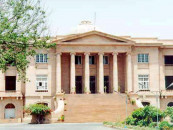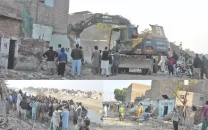PIA official admits technical fault
Says malfunctioning turbine blades couldn’t be replaced due to issues in design

The Havelian plane crash in 2016 was a consequence of a technical fault, Pakistan International Airlines’ (PIA) technical director admitted before the Sindh High Court on Tuesday.
He made the admission appearing before a two-member bench, headed by Justice Muhammad Ali Mazhar, during the hearing of a plea pertaining to investigation into the national flag carrier’s ill-fated flight PK-661 that crashed in Havelian.
PIA technical director further told the court the fault had occurred in the plane’s left engine but the other engine was working properly.
When the court asked why the aircraft’s turbine blades, which had malfunctioned, weren’t replaced, the technical director replied, “It was because of an issue in the design.”
He commented, “We have learned a lesson from the incident”.
At this, the court rebuked, “People spend money on tickets but what is the use if their lives are at risk [during the flight].” It further enquired from the PIA official whether the personnel responsible for the crash had been identified after the Civil Aviation Authority submitted its final investigation report.
“You let the plane fly despite it having a technical fault. Who is responsible for it?” the court questioned.
The court further asked PIA officials whether the airline ensured that the rest of its ATR were safe for travel after the accident.
At this, the counsel for PIA assured the court that all necessary safety measures had been taken. Moreover, PIA officials told the court that a new software was developed to help avoid accidents.
The court directed PIA officials to apprise it of all details pertaining to the process of checking aircraft and clearing them for flight.
Besides, the mother of the aircraft’s deceased captain claimed that her son was forced to fly the plane and was coerced into flying three aircraft a day.
“He was under pressure,” she remarked.
After the Sindh assistant advocate-general referred to the CAA’s report, in which PIA was held responsible for the crash, the court admonished the deputy attorney over his ignorance of the report’s contents.
“Why didn’t you read the report prior to the hearing? Don’t you want the report to be discussed here?” Justice Mazhar scolded the deputy attorney general.
Moreover, the court inquired as to how the CAA issued certificates of airworthiness.
The CAA director, however, responded that all required records had been submitted to the court and requested for more time to submit a reply pertaining to the enquiry.
Earlier, the petitioner submitted new records in connection with the crash.
The court sought replies from PIA and other parties in light of this new information. It further directed the CAA to submit a detailed reply, identifying persons and entities responsible for the crash in context of technical issues. The court also sought a report on ATR’s maintenance from the PIA at the next hearing on December 17.
At an earlier hearing on November 19, a final investigation report into the December 2016 PIA plane crash that left all 47 people on board dead revealed that the accident happened due to a technical fault and that the pilot was not responsible for the mishap.
Published in The Express Tribune, December 2nd, 2020.



















COMMENTS
Comments are moderated and generally will be posted if they are on-topic and not abusive.
For more information, please see our Comments FAQ